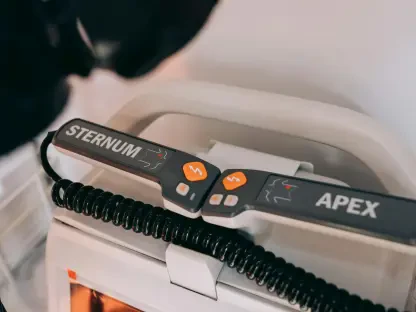Healthcare facilities face numerous challenges when selecting the appropriate flooring materials that offer a harmonious balance of aesthetics, cost, durability, maintenance, and infection control. These decisions are monumental as they have long-lasting effects on the facility’s operations and overall efficacy. As we approach 2025, industry professionals are diving deep into these multifaceted considerations to determine the best flooring solutions for healthcare environments. This involves evaluating the evolving landscape of flooring materials and identifying those that can withstand the rigorous demands of healthcare settings while enhancing patient care and safety.
The Importance of Longevity and Maintenance
In healthcare settings, it’s paramount that flooring materials can withstand the heavy use and stringent cleaning protocols that are part of daily operations. Experts such as Aiko Tanabe from Perkins&Will and Leah Wilkins from CannonDesign emphasize that durability and substantial maintenance requirements are crucial when selecting flooring options. The choice of flooring is not just about aesthetics; it impacts the long-term viability and performance of the space. Ensuring that materials can endure the wear and tear over time is vital, as failure to do so can significantly impair healthcare operations and even affect revenue.
Making well-informed decisions that balance current design standards with innovative and sustainable options is essential for long-term success. As part of this process, professionals must consider the flooring’s ability to handle continuous use and cleaning while also aligning with the overall design and functionality of the space. This approach helps mitigate risks associated with premature degradation and costly replacements, ultimately ensuring a reliable and enduring flooring solution.
Infection Control as a Priority
With recent data highlighting the impact of healthcare-associated infections (HAIs), infection control has emerged as a critical concern in the selection of flooring materials. This has prompted a reevaluation of traditional favorites like luxury vinyl tile (LVT), which are now seen as potential reservoirs for pathogens. As healthcare facilities strive to minimize infection risks, there’s a growing interest in seamless flooring options such as sheet flooring and poured epoxy products. These materials are particularly favored in patient rooms and areas with showers, where the potential for pathogen spread is higher. Seamless flooring options offer a significant advantage by reducing the number of places where bacteria and pathogens can accumulate, thus supporting the overall infection control efforts within healthcare facilities.
Seamless flooring not only enhances infection control but also simplifies the cleaning process, making it easier for staff to maintain hygiene standards. The shift toward these flooring materials represents a proactive approach to creating safer and healthier environments for patients and staff alike. Additionally, the healthcare industry must continuously adapt and respond to evolving data on infection control, ensuring that flooring choices support the broader goal of reducing HAIs and promoting patient safety.
Preparing for Installation
Proper floor preparation is essential to ensure the successful installation and long-term performance of sheet products in clinical environments. Healthcare facilities must use the correct leveling products and adhesives specifically designed for healthcare settings. The use of inappropriate materials, such as lightweight commercial underlayment products, can lead to structural issues and fail to support the heavy equipment commonly found in healthcare facilities. Ensuring that all preparatory steps align with industry standards is crucial to achieving a durable and stable flooring installation.
Preparation also encompasses evaluating the existing subfloor conditions, making necessary repairs, and ensuring that the surface is appropriately leveled and primed for the new flooring materials. This meticulous attention to detail helps prevent complications like uneven surfaces, which can affect both the aesthetics and functionality of the flooring. Investing in proper preparation ultimately leads to a more reliable and long-lasting installation, reducing the likelihood of costly repairs and replacements in the future.
Healthcare facilities must prioritize floor preparation as a critical step in the overall installation process. By adhering to best practices and using high-quality materials designed for healthcare environments, facilities can ensure that their flooring solutions meet the rigorous demands of daily operations while maintaining performance and appearance over time.
Embracing Sustainability
As sustainability becomes an increasingly important consideration in healthcare facility design, there is a growing push for environmentally friendly flooring options. Firms like Perkins&Will have noted significant improvements in the availability and performance of sustainable products over the past two decades. With a strong emphasis on reducing environmental impact, healthcare facilities are now looking toward PVC-free and phthalate-free flooring materials. The goal is to advance towards cradle-to-cradle solutions that not only minimize the environmental footprint but also manage the vast amounts of flooring waste generated during replacements.
Sustainable flooring options are not only better for the environment but also align with the broader goals of healthcare facilities to create healthier and more sustainable spaces for patients and staff. This trend reflects a broader industry shift towards environmental responsibility and the integration of sustainable practices in healthcare facility design and operations.
The focus on sustainability extends beyond material selection to include considerations of the entire lifecycle of the flooring. This includes factors such as manufacturing processes, installation methods, and end-of-life disposal or recycling options. By adopting sustainable flooring solutions, healthcare facilities can contribute to a healthier planet while also enhancing the overall health and well-being of their occupants.
Aesthetic Appeal and Practicality
Aesthetics play a critical role in choosing flooring for healthcare facilities, with wood-look materials such as light oak remaining popular choices for their ability to create a warm and inviting environment. However, the industry is now experiencing a trend toward warmer and more pronounced wood tones, moving away from the cooler gray shades that were previously widely favored. This shift aligns with the broader movement towards creating spaces that feel more comforting and less clinical, ultimately enhancing the overall patient experience.
Practical considerations also play a significant role in the selection process, with neutral flooring colors being preferred for their longevity and flexibility. These colors allow for easier updates to the space without the need for complete flooring replacements. However, it’s essential to avoid light tones that can show scuff marks and damage easily, ensuring that the flooring maintains its appearance and functionality over time.
Balancing aesthetic appeal with practicality is key to creating environments that are both visually pleasing and functional. Striking this balance requires a keen understanding of design trends and the unique needs of healthcare facilities, ensuring that the flooring choices support the overall goals of the space.
Popular and Cost-Effective Materials
Materials like rubber, linoleum, and terrazzo are favored for their long-standing reliability and evolving design options in healthcare settings. Rubber flooring is particularly valued for its acoustic properties and comfort underfoot, making it an excellent choice for areas where reducing noise levels and providing comfort to staff are priorities. Terrazzo, on the other hand, is renowned for its durability and ability to withstand high-traffic areas, making it a suitable choice for busy corridors and public spaces. Despite its higher cost, the long-term benefits of terrazzo, such as reduced maintenance and prolonged lifespan, make it a worthwhile investment for many healthcare facilities.
Cost-effective alternatives like LVT with terrazzo or watercolor looks offer aesthetic appeal without the high price tag, making clinical and waiting areas more inviting. These alternatives provide the visual appeal of more expensive materials while ensuring that budgetary constraints are met. By carefully selecting materials that offer a balance of aesthetics, durability, and cost-effectiveness, healthcare facilities can create functional and attractive spaces without compromising on quality or performance.
As healthcare facilities continue to evolve, the choice of flooring materials will remain a critical component in the design process. Whether opting for traditional, reliable materials or exploring innovative and cost-effective alternatives, the goal is to create environments that enhance patient care and support the needs of healthcare professionals.
Trends in Renovation Projects
Renovation projects in healthcare facilities are increasingly favoring non-directional, low-contrast flooring styles that facilitate seamless integration with existing flooring. This trend reflects the growing preference for designs that offer simplicity and continuity, creating a cohesive look throughout the facility. Thicker resilient tile and plank materials are appreciated for their ability to address level changes between old and new flooring, ensuring a smooth transition and reducing the risk of tripping hazards.
These renovation projects often involve upgrading outdated flooring materials with more modern and functional options, enhancing both the aesthetic appeal and performance of the space. The choice of flooring during renovations is critical to achieving a harmonious blend of old and new elements, ultimately creating environments that meet the current standards and expectations of healthcare facilities.
Renovation projects also provide an opportunity to introduce new flooring solutions that align with the latest trends and technologies. By carefully evaluating the specific needs of the facility and considering factors such as durability, maintenance, and infection control, healthcare facilities can ensure that their renovation efforts result in spaces that are both efficient and aesthetically pleasing.
Navigating Uncertainties
Healthcare facilities face numerous challenges when choosing the right flooring materials, aiming to find a balance between aesthetics, cost, durability, maintenance, and infection control. These decisions are crucial as they significantly impact the facility’s day-to-day operations and overall long-term effectiveness. As we edge closer to 2025, industry experts are delving deep into these complex considerations. Their goal is to select the best flooring solutions for healthcare settings that can endure the intense demands placed upon them.
The evaluation process involves examining the latest advancements in flooring materials and technologies to pinpoint those capable of withstanding heavy foot traffic, frequent cleaning, and the potential for spills and stains. Additionally, the chosen flooring must contribute to patient care by being slip-resistant and reducing the risk of falls, providing cushioning to comfort patients with mobility issues, and helping to create a calming and welcoming atmosphere.
Moreover, proper flooring can also play a crucial role in infection control by offering surfaces that are easy to clean and resistant to microorganisms. As healthcare facilities strive to improve patient safety and satisfaction, the emphasis on choosing the right flooring becomes ever more pronounced. This holistic approach ensures that healthcare environments remain not only functional and safe but also aesthetically pleasing and cost-effective in the long run.









